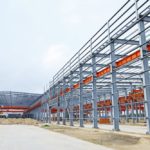Sector - Supply Chain
Construction sector sees light at the end of the tunnel

The UK’s construction sector has undoubtedly been one of the sectors worst hit by the pandemic over the past 18 months, says John Rozenbroek, CFO/COO at Capify.
Even after businesses were allowed to reopen, they were hit by staff shortages due to the so-called ‘pingdemic’ and social distancing measures that put the brakes on many projects. Combine this with material shortages, supply chain disruptions and trade restrictions, and it’s clear the sector has endured a particularly tough period.
Thankfully, construction SMEs are starting to see light at the end of the tunnel, with many businesses feeling more optimistic about the future. We recently completed a survey of over 250 UK SMEs, and it was great to see the feedback from the construction sector, which highlighted how many were responding to the challenges of the past 18 months, rebounding strongly and getting back on their feet.
Some of the key findings from the survey showed a clear focus on staff and resources. A total of 44% of construction SMEs identified investing in people and training as a priority over the next 12 months, demonstrating how they are really putting their people at the forefront of business strategy.
The Capify survey also found that recruiting new staff has become a top priority for UK construction SMEs with more than one in three expecting to increase the size of their workforce by more than 10% over the next 12 months. An additional 57% of construction companies expected their staff numbers to stay the same and only 4% were anticipating a reduction, suggesting a positive future for the sector.
The figures on recruitment expectations are in stark contrast to the previous 12 months, as 21% of construction businesses told us they reduced their staff numbers during the pandemic. This reduction is perhaps no surprise after the turbulence of the past year and a half, with businesses hit by numerous lockdowns and isolation orders.
People are truly a business’s greatest asset and it’s encouraging to see so many in the construction sector valuing this in their future plans with clear ambitions to invest in people and expand their workforces.
Recent data from the Office of National Statistic’s (ONS) annual construction statistics release found that total employment in construction fell in 2020, although the number of registered construction companies actually increased. ONS data also shows that the number of job vacancies in the construction sector has reached an all-time high.
It’s clear that there is an improving picture for the sector, but the challenge of people and resources could derail those that are trying to rebound strongly from the pandemic.
Keeping hold of the best staff and filling vacancies could be an issue for some and according to our survey, recruitment is expected to be a big challenge, with 44% of construction SMEs highlighting it as a key problem they expect to face in the year ahead.
It wasn’t top of the list, however. The issue of COVID and possible future lockdowns topped this list, with 56% of construction SMEs worried about the impact the virus may have again in the future. Rising inflation came second in the list, with 48% of respondents concerned about escalating costs.
The results of our survey show that we have hit a new phase in this pandemic – something of a tipping point for the future of many SMEs.
Businesses are starting to look towards the future more optimistically, focusing on investing in their workforce and recruiting new people. However, with the end of furlough, a lack of talent, rising inflation and the recent issues around energy prices, it’s no surprise that SMEs do have plenty of concerns in mind.
It could be a challenging 12 months for businesses in many sectors as margins become tighter – especially if increased overheads need to be managed alongside adding new staff. Cash flow is a perennial challenge in the construction sector, but construction SMEs must do all they can to ensure strong cash flow to be able to invest in their people and deliver on their growth ambitions.
If you would like to read more stories like this, then please click here
Related Articles
More Supply Chain Features
- Modular frameworks create a monumental opportunity for UK public sector construction
5 Sep 25
Modular Buildings 3, allows public sector organisations to access a verified list of modular construction suppliers quickly and easily.
- Pagabo provides clarity on impacts of new NPPS and PPNs
12 Mar 25
The Labour government’s new National Procurement Policy Statement (NPPS) sets out strategic priorities for public procurement.
- Alternative building practices are crucial to unlocking AI infrastructure benefits
7 Mar 25
With AI capabilities developing at an unprecedented pace, the government has announced its AI Opportunities Action Plan.






